 This information has been archived for reference or research purposes.
This information has been archived for reference or research purposes.
Archived Content
Information identified as archived on the Web is for reference, research or recordkeeping purposes. It has not been altered or updated after the date of archiving. Web pages that are archived on the Web are not subject to the Government of Canada Web Standards. As per the Communications Policy of the Government of Canada, you can request alternate formats on the "Contact Us" page.
Aerospace Issues
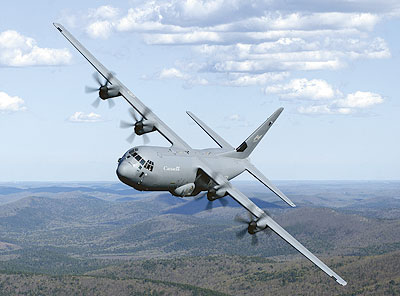
Lockheed Martin
The Lockheed C-130J Hercules in Canadian service will represent a quantum leap in Canada’s tactical airlift capability. Canada has ordered 17 such aircraft.
What Direction? The Future of Aerospace Power and the Canadian Air Force – Part 2
by Scot Robertson
For more information on accessing this file, please visit our help page.
Was Douhet Right? Air Power Thought and Operations in the Late 20th Century
Airpower contributed mightily to the long watch – and eventual victory – during the Cold War. For much of that period, Canada’s air forces were integrally involved in this great contest through the NATO and NORAD alliances. However, as the Cold War came to its mercifully anticlimactic ending, new thinking about the future of airpower was emerging in the United States and elsewhere. John Warden and John Boyd represented this new strand. Boyd, through his Discourse on Winning and Losing, and Warden, with The Air Campaign: Planning for Combat, sought to re-energize airpower and aerospace power thought.1 Both men have proven extremely influential in reviving strategic thinking in the United States Air Force (USAF) and beyond. Their ideas concerning the application of airpower, particularly strategic airpower, have shaped discussions for a decade or longer. While Warden’s writings are perhaps better known, largely because of his role in planning the air campaign for the Gulf War in 1991, John Boyd’s ideas have also contributed greatly. It is virtually impossible to pick up any academic or professional work dealing with airpower in the last decade-and-a-half and not see the influence of Warden and Boyd.2 In an extremely interesting discussion of their ideas, David Fadok hinted that perhaps the long-sought Holy Grail of airpower advocates – strategic paralysis – finally might be within reach. Fadok wrote: “The ideas of Boyd and Warden complement each other, and, together, have helped usher in the era of strategic paralysis by means of control warfare ... If true, the pursuit of strategic paralysis through control warfare, as advocated by Boyd and Warden, contains implications for how best to organize, equip, and employ the air forces of tomorrow.”3
Yet, even as Warden and other airpower thinkers were considering the future of aerospace power, the untidiness of the post-Cold War period offered several tests for air forces. Over the decade and a half since the end of the Cold War, there have been at least five occasions when significant levels of airpower have been employed. It would, therefore, behove professional airmen and academic commentators alike to take heed of any lessons that might have emerged from this body of experience. Will the experiences of the 1990s and the first few years of the 21st Century be indicative of an emerging trend? Will airpower become the force of first resort? Will the visions of the early airpower theorists finally be realized?
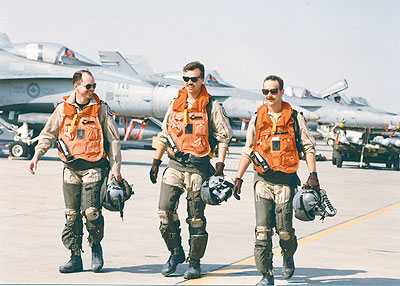
DND photo ISC91-5112 by Sgt. C. Colombe
Canadian CF-18 pilots on the flight line in Qatar during Operation Friction, January 1991.
The Persian Gulf War 1991
The first occasion that merits attention and analysis is the Persian Gulf War of 1991. There is much to be gleaned from this experience, and much that can serve to guide airpower planners as they contemplate the future.4 Broadly speaking, these lessons fall into two categories. On the one hand, there are many positive lessons that should prove of great utility in current planning efforts. On the other hand, there are numerous myths that have taken on the shape of lessons, and these are to be avoided.5
The conduct of the Persian Gulf War was something of a revelation for many. People watched in awe the performance of a coalition force that was characterized by a degree of technological sophistication married to doctrinal and operational concepts that resulted in a new vision of what high-intensity, fast-paced operations of the future might entail. That the opponent, Iraq, was a foe that was neither technologically advanced nor doctrinally sophisticated is something of a secondary consideration. The US-led coalition performed in a fashion that left many observers, commentators, and experts breathless.6 Much was learned about modern combat – what some termed fourth generation warfare.
In the first instance, one must note the contribution of airpower. While an unseemly debate took place in the immediate aftermath of the war concerning the true nature and extent of its contribution, there is no disputing that airpower was of overwhelming significance. The fact that airpower was deployed early in the conflict and ‘held the ring’ while ground forces flowed to the Persian Gulf is suggestive of the power of a modern air force equipped with a range of highly accurate, extremely lethal munitions.7
It is possible, however, to impart too much credit to airpower during the 1991 Persian Gulf War. Despite its central contribution, airpower was unable to ‘win the war’ on its own, even though some of the strongest and most vocal advocates have made such claims.8 Once the dust had settled – and the rhetorical excesses had died down – cold, dispassionate analysis revealed numerous flaws in the execution of the campaign. Some of the more serious deficiencies that have been identified were:
- insufficient target information at the outset;
- inefficient battle damage assessment;
- ineffective and inefficient Air Targeting Order (ATO) processes;
- communication difficulties;
- woefully unresponsive intelligence analysis;
- difficulty in diverting attacks to time-sensitive targets; and
- utter failure in the infamous “Scud-hunt.”9
Despite these shortcomings, airpower’s contribution to success in battle was significant – and some would say it was vital. Indeed, due to post-conflict analysis, many of these deficiencies have been corrected, and there is no question that air forces are now better equipped and doctrinally prepared to conduct future air offensives.
Operation Desert Fox
Perhaps because of its success during the Persian Gulf War, airpower seemed to become the instrument of choice for leaders and statesmen when they found themselves compelled to resort to force.10 This was clearly the case in Operation Desert Fox in Iraq during December 1998. Desert Fox was an effort to compel Saddam Hussein to live up to the obligations imposed at the end of the Gulf War of 1991. It was, however, a very limited effort designed to accomplish a very limited objective. In its execution, it was virtually an ‘air-only’ operation – if one accepts for the sake of argument that cruise missile attacks from US Navy and Royal Navy vessels constituted a manner of air attack.11
One needs to exercise some degree of caution in drawing lessons from Operation Desert Fox. The limited objectives and short duration – just some four days – makes it a rather shallow basis to determine whether the United States has corrected some of the deficiencies identified in conduct of the Persian Gulf War. Anthony Cordesman, a prolific analyst of the various military operations of the 1990s and early 2000s, particularly those in the Persian Gulf region, advocates a cautious approach in extrapolating from the Desert Fox experience. He wrote: “We need to take a hard and realistic look at the preliminary lessons ... It is now being touted as a triumph of military effectiveness, but in reality may well be just the opposite.”12
Cordesman’s analysis of the conduct of Desert Fox was insightful on a number of levels. For the most part, he eschewed the technical shortcomings, concentrating upon the apparent inability to connect operational means with strategic ends, cautioning that “killing exposed tanks and airplanes, winning air-to-air combat, destroying hangars and exposed ground-based air defenses is no guarantee of what will happen if we are fighting a guerrilla or unconventional war and that giving modern warfare a meaningful strategic outcome is a significant challenge.”13 This will be a major issue in future campaigns, and the question remains whether the forces of the US and any coalition that it forms will be up to this task.
Cordesman pointed to a number of areas in which the joint US-UK operation fell short. In his view, the following proved to be problematic:
- weapons effectiveness;
- concealment sites for Weapons of Mass Destruction (WMD);
- WMD industrial sites;
- command and control facilities;
- air bases and air base facilities;
- Republican Guard headquarters;
- integrated air defence system and surface-to-air missiles; and
- non-WMD industrial targets (oil facilities).14
Clearly, if these problems plagued the conduct of an operation as limited in time as Desert Fox, and if they have not been rectified since, then any operation that has larger objectives will be faced with major difficulties.
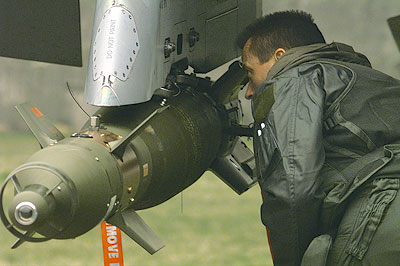
CF photo CKD99-201-01
Preflight inspection at Aviano, Italy, during Operation Allied Force, 1999.
Operation Allied Force
Operation Allied Force, the NATO campaign over Serbia, was the third major operation conducted in the 1990s that offered some indication of what might transpire in the future. During the summer of 1999, NATO conducted, ...an air campaign of unprecedented precision against the former Republic of Serbia. [However] For 78 days, the world’s most powerful alliance appeared on the verge of fragmentation. To NATO’s relief, Serbia capitulated after a military campaign fraught with gradualism and obtrusive political meddling. For many airpower proponents, Operation Allied Force vindicated decisive airpower doctrine. For others, Allied Force was a misapplication of core USAF aerospace doctrine ... [and] highlighted a significant doctrinal imbalance between decisive and coercive airpower.15
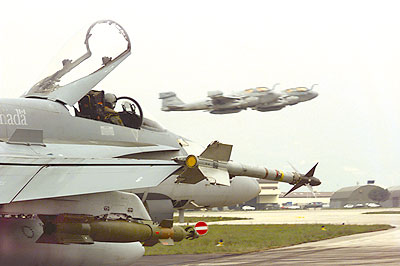
DND photo CKD99-2029 by MCpl Danielle Bernier
A CF-18 awaiting takeoff at Aviano, Italy, as part of Operation Echo/Operation Allied Force.
Allowing for the unique difficulties inherent in conducting coalition war, there are a number of factors that should be taken into account in considering the lessons of Operation Allied Force. The clearest lesson to emerge from the Kosovo campaign appears to have been the need to have a major ground force presence to compel the enemy to at least consider the possibility of an invasion. In the Operation Allied Force post-mortem, some commentators and analysts suggested that it was only the presence of the Kosovo Liberation Army (KLA) in some strength, backed by a large NATO force in Montenegro, that finally forced Slobodan Milosevic to capitulate.16 It may never be possible to ascertain exactly what forced the Serbs to lay down their arms.
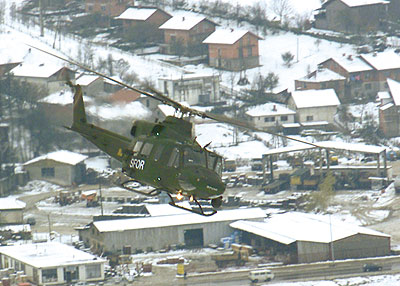
DND photo ISD01-102 by Sgt Gerry Pilote
A Canadian Griffon helicopter on a mission in Bosnia-Herzegovina as part of Operation Palladium, Canada’s contribution to the NATO Stabilization Force (SFOR).
Operation Enduring Freedom
It is probably too early to draw definitive conclusions from the US-led operation in Afghanistan following the terror attacks upon New York City and Washington on 11 September 2001. Moreover, the operation in Afghanistan may not be indicative of future undertakings. This operation against the Taliban government and forces was conducted with the assistance of local opposition forces, most notably the Northern Alliance. In addition, the presence of a significant US Special Forces capability on the ground assisted precise and near-real-time designation of targets for the air forces. This may have been a sufficiently unique circumstance that it might not be possible to count upon a similar capability in a future situation. In the first instance, the majority of targets were outside cities or built-up areas. Second, the number of targets were, in reality, quite limited. In a very preliminary analysis of the air component of Operation Enduring Freedom, Anthony Cordesman notes that the US air forces flew only “...7-15 bomber and 7-15 strike/attack aircraft per day during the first week, and some returned not having used their munitions. These figures crept up towards the 100 per day level towards the end of the second week.”17
Operation Iraqi Freedom
If it is too early to assess the role of airpower in Afghanistan, then it is definitely far too early to make any definitive judgments about airpower in Operation Iraqi Freedom.18 However, some preliminary assessments can be made. First, and in stark contrast to Operation Desert Storm, there was no prolonged air campaign against Iraqi forces. Instead, the campaign was a tightly integrated, parallel operation. Writing in The Observer, Major General (ret’d) Julian Thompson pointed out that the desired strategic end – namely the removal of Saddam Hussein and his regime from power – “...would have been ill-served by a huge air assault on the civilian population, followed by a plodding advance to Baghdad.” However, Thompson also commented, “...the role of airpower in this war cannot be overstated. All coalition fighter-bombers can deliver smart weapons. From a loitering position overhead, one B1 bomber can attack 16 targets. Much of the air-delivered ordnance is satellite guided ... Close air support of ground operations by Apache and Cobra helicopters and A-10 tankbuster planes was a battle winning factor. UAVs passed real-time video and other information back to headquarters day and night.”19
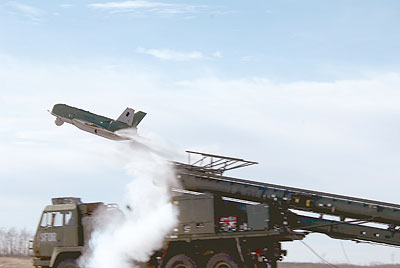
CF photo GNHW2005-001-006 by MCpl Robert Earl
The Sperwer Tactical Unmanned Aerial Vehicle (TUAV). Are UAVs the way ahead for Canada?
New Vistas for Air Power
In light of the experience of the past decade-and-a-half, aerospace power has certainly proven to be extremely important. Few commanders would want to go into battle without access to modern aerospace capabilities. That said, however, there is again a rather vigorous debate taking place over the role and place of aerospace power and air forces. In fact, there are really two separate yet connected debates. While the emphasis of these debates is somewhat different, what lies at the core is the age-old question of the primacy of air power. The first debate centres upon what has come to be referred to as Effects Based Operations (EBO). The second debate concerns what is called the Afghan model of conflict. Each of these debates will now be discussed in some depth.
Effects-Based Operations: Old Wine in a New Bottle?
Although it is best left for historians to judge, it is probably true that the ideas of John Boyd and John Warden will become as influential and important proponents for airpower as those of Douhet, Trenchard, and Mitchell were for their time. In the wake of Boyd’s and Warden’s contributions to aerospace power theory have come individuals such as Robert Pape, Eliot Cohen, Thomas Keaney, Daniel Byman, Benjamin Lambeth, and, most recently, David Deptula, and they have been re-invigorating discussions about how airpower might be employed in the future.20 The experiences of the late 1990s and early 2000s, coupled with intellectual ferment in discussions of the future of aerospace power, may be indicative of a new era. During this time frame, airpower has effectively become the force of first resort. The Gulf War of 1991, operations such as Desert Fox, Deliberate Force, and Allied Force, were, for the most part, dominated by air operations, although many individuals would contest this characterization.21 However, in most of these instances, air operations appeared to be the first consideration. If the experiences of the past decade or so are in any way indicative of the future, then airpower in the 21st Century may become the new form of ‘gunboat diplomacy’ that characterized the 19th Century. If this is a valid assertion, or, at the very least, is not too far off the mark, the question for Canada is what to do about it and how to proceed?
The renaissance of thinking about airpower – or perhaps more correctly, aerospace power – heralds new prospects for the employment of aerial weapons. Ideas that have come to be referred to as Effects-Based Operations (EBO) may hold new and significant possibilities. Military operations conducted in the future, so the current thinking goes, will need to place increased emphasis upon establishing influence over the mind of an adversary, while keeping casualties and collateral damage to a minimum. Lieutenant Colonel Price T. Bingham, writing in Military Review, offers the following description:
[EBO is] designed to create effects that make it impossible for a specific system to perform a function that is vital to an enemy’s ability or will to continue effective resistance. It calls for achieving system-wide functionaleffects without destroying a significant part of the entire system ...These advantages are derived from the potential to achieve desired objectives faster and with far fewer casualties ...22
Effects-Based Operations, proponents argue, will offer the possibility of achieving this aim through a combination of physical and psychological effects. Although EBO may offer an increased possibility of achieving the desired aim without the need to always resort to attrition warfare, it is, at present, an aspiration.23
Therefore, whether this new concept for the application of airpower will bear out the hopes of its creators remains to be seen. For the moment, however, EBO is a work in progress, much like the ideas of the Air Corps Tactical School were in the late 1930s. Nor is the idea of EBO without its critics.24 Some see EBO as merely ‘old wine in a new bottle.’ Others see it as just another tool by which air forces can defend budget shares in a time when competition for scarce resources is intense. In an eerily familiar way, the discussions surrounding EBO appear to be getting caught up in inevitable inter-service rivalries, just as the ideas of Trenchard and Mitchell did in the 1920s. Hopefully, however, these debates will not reach the levels of acrimony – or rhetorical excess – that marked those of the 1920s and 1930s.
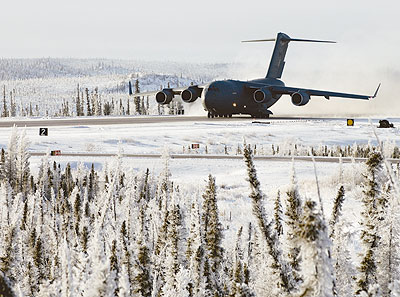
CF photo CK2007-0456-43 by Cpl Jean-Francois Lauzé
Canada’s new CC-177 Globemaster III strategic transport.
The Afghan Model
While discussions over EBO continue apace, another avenue of debate has opened. This concerns the centrality of air power during Operation Enduring Freedom. The most recent manifestation is between Richard Andres, Craig Wills and Thomas Griffiths on one hand, and Stephen Biddle on the other. The focus of the debate turns upon whether the role played by aerospace power in the Afghan conflict will constitute a model for the future. Andres, Wills, and Griffiths argue that,
“...a small group of Afghan rebels working with US Special Forces and US airpower defeated the Taliban’s conventional army and overthrew the regime. ... The speed with which these tactics worked in Afghanistan surprised everyone, from National Security Council (NSC) planners to the combatants participating in operations. What many of the war’s planners had envisioned as a holding operation to prepare the battlefield for a sizable conventional force ended in the rapid defeat of the 50,000-man Afghan army and the fall of the Taliban regime it supported. This new way of war also resulted in a country primarily occupied and policed by indigenous forces.”25
Andres, Wills, and Griffiths, as well as others, term this the Afghan model. The essence of the Afghan model is that “...airpower degrades enemy communications throughout the theater of war. Then, ...special forces use light indigenous troops as a screen against enemy infantry and force the enemy to mass before calling in precision air strikes.”26 The upshot of the Afghan model is that large, heavy, conventional ground forces are not required. “The model represents an important, even revolutionarily, new tool in the United States’ foreign policy arsenal. Ultimately, the model allowed the US military to substitute airpower, SOF, and local allies for tens of thousands of American troops in the last two wars. This is economy of force in its purest form.”27 Is it also another argument for the war-winning potential of airpower?
Stephen Biddle, in a response to the arguments developed by Andres, Wills, and Griffiths conceded that, “...the 2001 Afghanistan campaign toppled the ruling Taliban regime without a large US ground force commitment ... [giving] rise to the “Afghan model” of warfare, in which indigenous allies replace American conventional ground troops by exploiting U.S. airpower and small numbers of American special operations forces (SOF).”28 However, Biddle contends that the Afghan model, or at least the Afghan model as described by Andres, Wills, and Griffiths, is anomalous. Local conditions and local circumstances were so unique, that to draw broad, definitive, and sweeping conclusions is risky at best, and dangerous at worst. In his view,
...only allies with skills and motivation that approximate their enemy’s will suffice. Inept or ill-motivated allies cannot realize the potential of US airpower and SOF against competent enemies, whether in the first world or anywhere else. As many prospective allies are even less skilled than their state opponents, this implies many fewer opportunities for the model to produce Afghanistan’s results. This disagreement is important. The wrong perception of the Afghan model’s applicability could produce policy failure, an ill-structured military, or lives needlessly lost in misbegotten wars.29
Clearly, there is a significant difference of view concerning the Afghan model. A resolution, if one is indeed possible, is important, and for a number of reasons. First and foremost, the Afghan model will, if accepted and built upon, affect future operations. Secondly, it may well affect procurement and force design decisions. As Peter Paret once reflected:
The strategy and operations of any war can be understood only in the light of conditions of the ten or twenty years before its beginning. Technology, organization, doctrine, training, command and staff appointments – all the essentials of action in war – are put in place and developed in peacetime. The testing experience of combat will bring about change, but prewar elements continue to affect many events throughout the longest of conflicts.30
The danger lies, as Thomas Donnelly has observed recently with respect to the US Air Force, in that there is a “...distinct danger in taking for granted the relatively low air defense threat in which the United states operates today. ... This is unlikely to remain the case in the future. One need only review a brief list of potential adversaries – Iran, North Korea, Pakistan, and China – to recognize that many of America’s possible enemies’ field forces would badly strain the current or planned capabilities of the US Air Force.”31 For Donnelly, as for so many others, the danger they see is being captured by what they refer to as ‘presentism.’
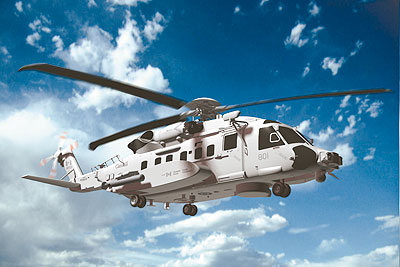
Photo by Sikorsky Corporation
The Sikorsky CH-148 Cyclone, Canada’s new maritime helicopter, which has been chosen to replace the venerable Sea King.
Into the 21st Century: What Next For Canada’s Air Force?
If airpower and aerospace power stand at the threshold of new and powerful strategic possibilities, what will this mean for Canada’s air force? This is not an easy question, nor, in all likelihood, will the answer be very comforting. In the first instance, it would be well to recognize at the outset that Canada will not have a full-service air force, as it were. In this, Canada will not be alone. Aside from the USAF, no air force will be able to muster the resources to blanket completely the full range of aerospace power capabilities. Arguably, even the USAF will have difficulties in maintaining a full service capability. Canada, then, will have to make choices. The question that will bedevil defence planners in general, and air force planners in particular, is how to make those choices.
The vexing situation that confronts air force planners as they contemplate the future is how to transform an air force that was once largely focused upon an air superiority/interception capability, and, at least for the present, seems largely focused upon airlift, into a force that will be able to conduct Effects-Based Operations.32 Whether the air force will be able to make that transformation is an open question. Yet, on the basis of past practice and evidence, the prospects do not seem overly positive. Arguably, force development over past decades has operated in a manner that can be reduced to a crude and simplistic, but perhaps accurate adage – we want what we want because we have what we have. While this is something of a caricature, it may not be too far off the mark. However, with the Canadian Forces as a whole facing the need to transform, this approach is nno longer sufficient. The resources are not available for a block transformation of all services – army, navy, and air force.
Some have argued that Canada will have to grasp the nettle and build niche forces. Various reports, recommendations and studies conducted in the 1990s argued their particular ‘pet theories.’33 This is all well and good, but the CF has already become, perhaps unconsciously so, a niche force. How much more of a niche force can it become? What will it concentrate upon? What will it give up? What are the risks to any particular course of action? While neither these questions nor the basic dilemma are new, the challenge may be greater than at any time in the past half century.
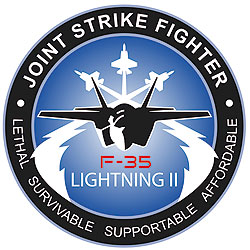
Lockheed Martin
In contemplating this thorny problem, defence planners would do well to consider Paul Bracken’s discussion of the “military after next.”34 While Bracken was writing of the dilemma that confronted the US armed forces in the early 1990s, his central point is appropriate to any nation facing a similar problem. He wrote:
...[the] military posture for the next 20 years is conceptualized implicitly in terms of problems of today, rather than in terms of deeper forces that reflect both the changing character of war and the military transformation taking place in the world, [and that] (t)he focus on the immediate means that a larger, more important question is not being asked: How should planners redesign the ... military for an entirely new operational environment, taking account of revolutionary changes in military technology and the possible appearance of entirely new kinds of competitors? There is not enough fresh thinking on this question, thinking that starts with a clean sheet of paper and examines the revolutionary impact of technology on US strategy and force structure.35
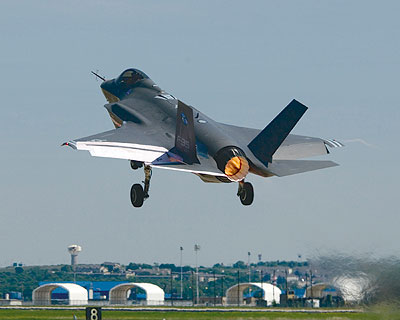
Lockheed Martin
Will 65 Lockheed Martin F-35 Lightning II stealth multi-role fighters be ‘in the cards’ for Canada’s future air force as a replacement for the ageing CF-18 Hornets? The nation currently has until 2012 to decide.
Future Prospects
Unfortunately, in an article such as this, there can be no definitive conclusion. There can only be a look to the future, informed by past experience. While it would be re-assuring to think that aerospace power has a bright future in Canada, the record of the past century suggests that this may not necessarily be the case. At the very least, the path will be difficult. At root, the most significant question will be how to look beyond the horizon. For that, Canada’s air force will require a strategic perspective that to some extent has eluded it during the 20th Century. Developing a strategic culture within the air force is essential. It is clear that for Canada’s air force, the problems of today are very real and by no means insignificant. However, the fundamental challenges lie ahead. How will the air force confront a complex and unpredictable future? Re-kindling, or even kindling the strategic flame, is the true challenge.
If advocates of the Afghan model are indeed on to something significant, and if the proponents of Effects-Based Operations are more or less correct in asserting that aerospace power is at the cusp of a new era, then Canada’s air force should be exploring these issues with vigour. This is perhaps the most important and most vexing challenge that will need to be addressed as aerospace power stands at the threshold of its second century. For Canada, airpower, aerospace power and air forces have, despite significant obstacles and hurdles, served it well throughout the 20th Century. The challenge is to ensure that these components continue to serve well and appropriately in the next century.
![]()
Doctor Scot Robertson is an Associate Professor in the Department of History and Classics at the University of Alberta, where he teaches military history. Prior to this, he taught at the Royal Military College, and was a defence scientist and strategic analyst with the Department of National Defence.
Notes
- John Boyd never produced a succinct summary of his seminal briefing entitled Discourse on Winning and Losing. Versions of it abound in filing cabinets and on bookshelves of professional airmen and academics worldwide. The School of Advanced Air and Space Studies has reproduced a copy of Boyd’s briefing. It is also widely available on the Internet. One link that contains the briefing and a wealth of other material is <http://www.d-n-i.net/second_level/boyd_military.htm>. There have been two recent biographies of Boyd. Grant Hammond, The Mind of War, (Washington DC: Smithsonian Institute, 2001.) and Robert Coram, Boyd: The Fighter Pilot Who Changed the Art of War, (Boston: Little Brown, 2002). [John Warden, The Air Campaign: Planning for Combat, (Washington: Pergamon, 1989.) Warden has subsequently written numerous articles that have appeared mostly in professional journals.
- David S. Fadok, John Boyd and John Warden: Air Power’s Quest for Strategic Paralysis, (Maxwell AFB, AL: Air University Press 1995).
- Ibid., p. 48.
- It may not be stretching things too far to suggest that the Persian Gulf War was one of the most-analyzed wars of the second half of the 20th Century. The wealth of literature available in the public realm is dwarfed by the voluminous studies and analyses that remain, to date, classified.
- Grant Hammond, “Myths of the Gulf War: Some Lessons Not to Learn,” in Airpower Journal, Fall 1998, pp. 6-18.
- We would do well to recall the sometimes-apocalyptic forecasts of thousands upon thousands of coalition casualties. In reality, the numbers on the coalition side numbered in the few hundreds.
- It must be remembered that the actual percentage of smart weapons employed during the Gulf War was quite small. Subsequent conflicts have witnessed a much higher percentage of smart weapons employed. There is, however, a vigorous debate over whether this is necessarily a positive development. The cost of smart weapons is such that fewer are available, and stocks may be depleted too early in a conflict.
- In the immediate aftermath of the war, a sign was erected in the cafeteria at the US Air War College at Maxwell Air Force Base that bore the slogan, “Douhet was right.”
- For a comprehensive discussion of these and other “failures” see Eliot Cohen, “The Mystique of US Air Power”, Foreign Affairs, Vol. 73, No 1, January-February 1994, pp. 109-123; Eliot Cohen “The Meaning and Future of Air Power”, in ORBIS, Vol. 39, No. 2, Spring 1995, pp. 189-201. See also, Grant Hammond, “Myths of the Gulf War: Some Lessons Not to Learn,” in Airpower Journal, Fall 1998, pp. 6-18.
- Cohen, “The Mystique of US Air Power.”
- For an analysis of the Desert Fox operation, see Anthony Cordesman, The Military Effectiveness of Desert Fox: A Warning About the Limits of the Revolution in Military Affairs and Joint Vision 2010, (Washington DC: Center for Strategic and International Studies, December 1998).
- Ibid., p.4.
- Ibid., p.5.
- Ibid., pp. 20-27.
- Paul Strickland, “USAF Aerospace Power Doctrine: Decisive or Coercive?” in Aerospace Power Journal, Vol. 14, No. 3, Fall 2000. p. 13.
- A survey of this debate can be found in Stephen Biddle, “The New Way of War? Debating the Kosovo Model,” in Foreign Affairs, Vol. 81, No. 3, Fall 2002, pp. 139-141. More comprehensive analysis is provided by Andrew Bacevich & Eliot Cohen (eds.), War over Kosovo (New York: Columbia University Press, 2001); Stephen T. Hosmer, Why Milosevic Decided to Settle When He Did (Santa Monica, CA: RAND, 2001); and Benjamin S. Lambeth, NATO’s Air War for Kosovo (Santa Monica, CA: RAND, 2001) and Andrew L. Stigler, A Clear Victory for Air Power: NATO’s Empty Threat to Invade Kosovo, in International Security, Vol. 27, No. 3, Winter 2002-2003, pp. 124-157.
- Anthony Cordesman, The Emerging Strike Patterns in the Air War in Afghanistan (Washington: Center for Strategic and International Studies, October 2001)
- A real assessment will have to wait for the public release of any lessons-learned reports. To date, remarkably little substantive material is available. Anthony Cordesman, the prolific writer from the Center for Strategic and International Studies in Washington, has produced the first serious attempt at analyzing the military operations – The Iraq War: Strategy, Tactics, and Military Lessons (Washington: Center for Strategic and International Studies, Significant Issues Series, September 2003). Various drafts of the report have been available on the CSIS web site at <http://www.csis.org/features/iraq_instantlessons.pdf>.
- Major General (ret’d) Julian Thompson, “Air power was devastating and Iraqi forces lamentable,” in The Observer, 13 April 2003, available at <http://militaryweek.com/OIF.shtml>.
- Robert Pape, Bombing to Win: Air Power and Coercion in War (Ithaca, NY: Cornell University Press, 1996); Thomas Keaney and Eliot Cohen, Revolution in Warfare: Air Power in the Persian Gulf (Annapolis, MD: Naval Institute Press, 1995); Daniel L. Byman, Matthew C. Waxman, & Eric Larson, Air Power as a Coercive Instrument, RAND Report MR-1061-AF, (Santa Monica, CA: RAND Corporation, 1999); Benjamin Lambeth, The Transformation of American Air Power (Ithaca, NY: Cornell University Press, 2000); David Deptula, Firing for Effect: Change in the Nature of Warfare (Arlington, VA: Aerospace Education Foundation, 1995).
- There has been no shortage of critics of this view. See, for instance, Major General (ret’d) Robert Scales, Certain Victory: The US Army in the Gulf War (Fort Leavenworth, KS: U.S. Army Command & General Staff College, 1994).
- Lieutenant Colonel Price T. Bingham, “Air Power Targeting Theory: A Key Element in Transformation,” in Military Review, May-June 2002, p. 34.
- To date, the best discussions of EBO are: David Deptula, Firing for Effect, Edward C. Mann, Gary Endersby and Thomas R. Searle, Thinking Effects: Effects-Based Methodology for Joint Operations, (Maxwell AFB, AL: Air University Press, 2002), and T.W. Beagle, Effects-Based Targeting: Another Empty Promise? (Maxwell AFB, AL: School of Advanced Airpower Studies, 2000).
- For an interesting discussion, see Allen W. Batschelet, Effects-based Operations: A New Operational Model? (Carlisle Barracks, PA: Army War College, 2002). Batschelet argues, sometimes persuasively, that EBO is really old wine in a new bottle, and that the US Army has pursued the same ends – namely psychological effects on the enemy – for decades. In this sense, one can see emerging the type of inter-service rivalry that marked, or perhaps more accurately, marred the debates in the 1920s and 1930s concerning the psychological/morale effect of strategic bombardment and the notion of the industrial web targeting philosophy of the US Air Corps Tactical School.
- Richard Andres, Craig Wills and Thomas E. Griffiths Jr., “Winning With Allies: The Strategic Value of the Afghan Model,” in International Security, Vol. 30, No. 3, Winter 2005-2006, p. 124.
- Ibid., p.127.
- Ibid., p.160.
- Stephen D. Biddle, “Allies, Airpower and Modern Warfare: The Afghan Model in Afghanistan and Iraq,” in International Security, Vol. 30, No. 3, p. 161.
- Ibid., p. 162.
- Peter Paret, in the Foreword to Harold R. Winton, To Change an Army: General Sir John Burnett-Stuart and British Armoured Doctrine, 1927-1938, (Lawrence, KS: University Press of Kansas, 1988) p. vii.
- Thomas Donnelly, “Strategy and Air Power,” in National Security Outlook, March 2005. (Washington: American Enterprise Institute, March 2005), p. 4.
- This is not to denigrate or diminish the ‘other’ capabilities resident in the Canadian Air Force. However, it is probably fair to say that the core capability, at least as air force planners view it, is the fighter platform. In that sense, the Canadian Air Force is still plagued by Carl Builder’s Icarus Syndrome. That is, the air force is still wedded to platforms and roles, rather, perhaps, than searching for ‘effects.’
- The most notorious of these was a report by the Canada 21 Committee that was issued in advance of the 1994 Defence White Paper. It recommended, in effect, that because of the radical change brought about by the end of the Cold War, the Canadian Forces could eschew hard power and rely instead on soft constabulary capabilities. Recent reports by the Conference of Defence Associations, the Royal Canadian Military Institute, and The Council for Canadian Security in the Twenty-first Century, while avoiding the ill-conceived recommendations of the Canada 21 Committee, sometimes advocate pet theories.
- Bracken developed this argument in a compelling, but perhaps little noticed article. See Paul Bracken, “The Military After Next,” in The Washington Quarterly, Autumn 1993, Vol. 16, No. 4, pp. 157-175.
- Ibid., p 157.






